
Hoopoe
"Upupa epops, not unfrequently visits Britain, where it has nested on several occasions; it breeds from…
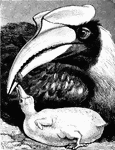
Female Hornbill Laying Down Feeding Her Young
"Dichoceros bicornis of India and the Malay countries has a large yellowish-red casque, hallowed and…

Plait-billed Hornbill
The Rytidoceros undulatus, Plait-billed Hornbill, or Wreathed Hornbill, has black wings, belly, and…
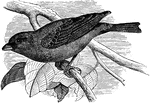
Indigo-bird
"Passerina cyanea. Indigo Painted Finch. Indigo-bird. Adult male: Indigo-blue, intense and constant…

jackdaw
"Corvus monedul. Jackdaw. The species throughout uniform lustrous black, including the bill and feet;…
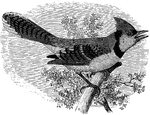
Blue Jay
"Cyanocitta cristata. Blue Jay. Male: Purplish-blue, below pale purplish-gray, whitening on throat,…

Canada Jay
"Perisoreus canadensis. Canada Jay. Whiskey Jack. Moose-bird. Gray whitening on head, neck, and breast;…
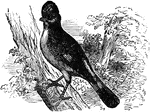
Eurasian Jay
"European Jay. Garrulus glandarius. With the wings much shorter than or about equalling the tail, both…

Long-crested Jay
"Cyanocitta stelleri macrolopha. Long-crested Jay. Upper parts sooty umber-brown, with a faint blue…

A Kea Sitting a Tree Branch
"Nestor notabilis, the Kea of the south island of New Zealand, has olive-green plumage with blackish…
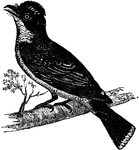
King-bird
Tyrannus carolinensis. King-bird. Bee-martin. No olive nor decided yellow. Only outer primaries obviously…
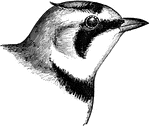
Shore Lark
"Shore Lark or Horned Lark. Upper parts in general pinkish-brown, this pinkish or vinaceous or liliaceous…

Shore Lark
"Shore Lark or Horned Lark. Upper parts in general pinkish-brown, this pinkish or vinaceous or liliaceous…
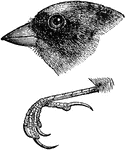
Red-poll Linnets
"Bill small, short, straight, very acute, more or less compressed, the lateral outlines usually a little…

Black-breasted Longspur
"Rhynchophanes maccowni. Black-breasted Longspur. Bay-winged Longspur. Upper parts slate-gray, streaked…
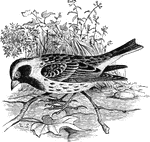
Lapland Longspur
"Centrophanes lapponicus. Lapland Longspur. Whole head, throat and breast jet-black, bordered with buffy…

magpie
"Pica. rustica hudsonica. Lustrous black, with green, purple, violet, and even golden iridescence, especially…
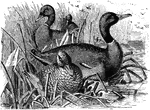
Mallards
"Anus boscas. Mallard. Wild or Domestic Duck. Green-head. Bill greenish-yellow. Feet orange-red. Iris…

Motmot
"Momotus brasiliensis, the Motmot, from Guiana to Northern Brazil, is somewhat similar in colour (to…

American Nutcracker
"Picicorvus. American Nutcracker. General characteristics of the European Nucifraga. Bill slenderer,…
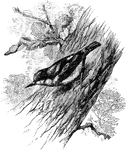
Nuthatch
"The colours in Sitta caesia, (Nuthatch) which ranges over nearly all the Palaearctic and Indian Regions,…
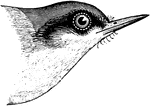
Brown-headed Nuthatch
"No black cap or white stripe on head. Upper parts dull ashy-blue; under parts sordid or muddy whitish.…
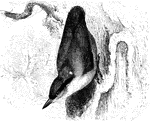
European Nuthatch
"Crown clear hair-brown; a white spot on nape; middle tail-feathers plain." Elliot Coues, 1884.

Red-breasted Nuthatch
"Upper parts leaden-blue the central tail-feathers the same; wings fuscous, with slight ashy edgings…
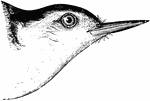
White-Breasted Nuthatch
"Upper parts, central tail-feathers, and much edging of the wings, clear ashy-blue; whole crown, nape,…

Baltimore Oriole
"Icterus galbula. Baltimore Oriole. Golden Robin. Firebird. Hangnest. Adult male: Black and orange.…
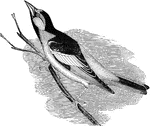
Bullock's Oriole
"Icterus bullocki. Bullock's Oriole. Adult male: Similarly black and orange, the orange invading the…

Golden Oriole
"The Golden Oriole, Oriolus galbula, which breeds exceptionally in England, is orange-yellow, with black…

D'Albertis' Bird of Paradise
"Drepanornis albertisi, D'Albertis' Bird of Paradise, is rufous-brown, with green throat and ante-ocular…
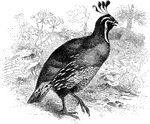
Californian Partridge
"Lophortyx californica. Californian Partridge. Valley Quail. Male: With a small white line from bill…

European Partridge
"Coturnix. Bill smaller and much slenderer than that of any of the foregoing genera of Odontophorinae;…
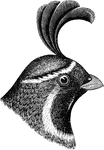
Gambel's Partridge
"Lophortyx gambeli. Gambel's Partridge. Arizona Quail. Male: Without white loral line; forehead black…

English Pheasant
English Pheasant. Common Pheasant. Phasianus colchicus. Adult plumage: Maroon breast, orangey flanks,…
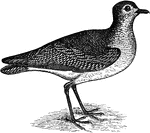
American Golden Plover
"Charadrius dominicus. American Golden Plover. Field Plover. Bull-head Plover. Upper parts black, everywhere…
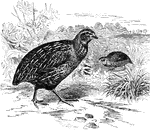
Common Quail of Europe
"Coturnix dactylisonans. Messina Quail. Migratory Quail. Common Quail of Europe. Upper parts variegated…
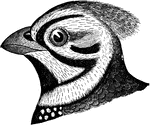
Massena Quail
"Cyrtonyx massena. Massena Partridge. Male: Upper parts intimately waved with black and reddish-brown…

Mountain Quail
"Orortyx picta. Plumed Partridge. Mountain Quail. Back, wings and tail olive-brown, the inner secondaries…
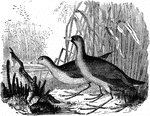
Carolina Rail
"Porzana carolina. Carolina Crake. Common Rail. "ortolan." Above, olive-brown, varied with black, with…

Clapper Rail
"Rallus longirostris crepitans. Clapper Rail. Salt-water Marsh-hen. Mud-hen. Above, variegated with…
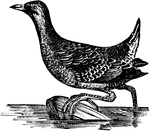
Small Carolina Rail
"Porzana carolina. Carolina Crake. Common Rail. "ortolan." Above, olive-brown, varied with black, with…
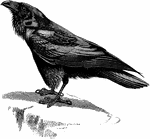
Raven
"Corvus corax, the Raven, are generally black with a purplish or greenish gloss, and frequently with…

American Raven
"Corvus corax. American Raven. Feathers of throat somewhat stiffened, lengthened, pointed, lying loose…
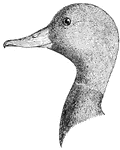
Large Redhead
"Fuligula ferina americana. Red-head. American Pochard. The feathers of the head somewhat full and puffy,…

Small Redhead
"Fuligula ferina americana. Red-head. American Pochard. The feathers of the head somewhat full and puffy,…
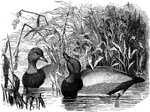
Redheads
"Fuligula ferina americana. Red-head. American Pochard. The feathers of the head somewhat full and puffy,…
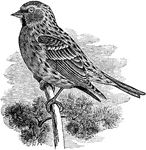
Common Redpoll
"Aegiothus linaria. Common Redpoll. Common Red-poll. Frontlet, lores, and throat-spot sooty-black. Crown…
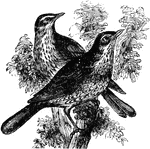
European Redwing
Two European Redwing birds sitting on a tree branch. These song birds are usually brown with darker…

Blue-headed Saw-bill
"Momotus caeruleiceps. Blue-headed Saw-bill. The central tail-feathers are long-exserted, and spatulate…
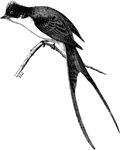
Scissor-tail
"Milvulus tyrannus, Scissor-tail, normally exhibits olive, grey, yellow, or white in varying proportions."…

Black Scoter
"Oidemia americana. American Black Scoter. Sea Coot. Adult male: Plumage entirely black, less glossy…

Northern Shoveler
"Spatula clypeata. Shoveller Duck. Broad-bill. Bill blackish; iris orange-red: feet vermilion-red. Head…
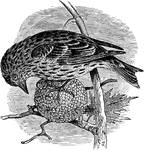
Pine Siskin
"Carduelis pinus. Pine Linnet. Pine Finch. American Siskin. Pine Siskin. Continuously streaked, above…
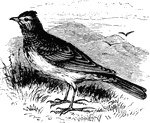
Skylark
"Sky-Lark. Upper parts grayish-brown, the feathers with darker centers; under parts whitish, tinged…
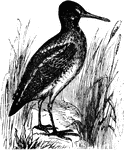
English Snipe
"Gallinago media. European Snipe. English Snipe. In size, form, and general coloration indistinguishable…
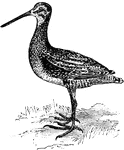
Small Wilson's Snipe
"Gallinago wilsoni. American Snipe. Wilson's Snipe. "English" Snipe. Jack-Snipe. Crown black, with a…

Wilson's Snipe
"Gallinago wilsoni. American Snipe. Wilson's Snipe. "English" Snipe. Jack-Snipe. Crown black, with a…
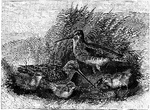
Family of Snipes
"Gallinago wilsoni. American Snipe. Wilson's Snipe. "English" Snipe. Jack-Snipe. Crown black, with a…

Song Sparrow
"Melospiza fasciata. Song Sparrow. Silver-tongue. Below, white, slightly shaded with brownish on the…
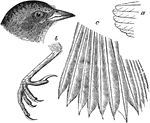
The Details of a Seaside Sparrow
"Ammodramus. Seaside Sparrow. Bill remarkably slender and lengthened for this family, with culmen toward…
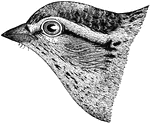
Chipping Sparrow Head
"Spizella domestica. Chipping Sparrow. Chipping Bird or Chippy. Hair-bird. Bill black; feet pale; crown…